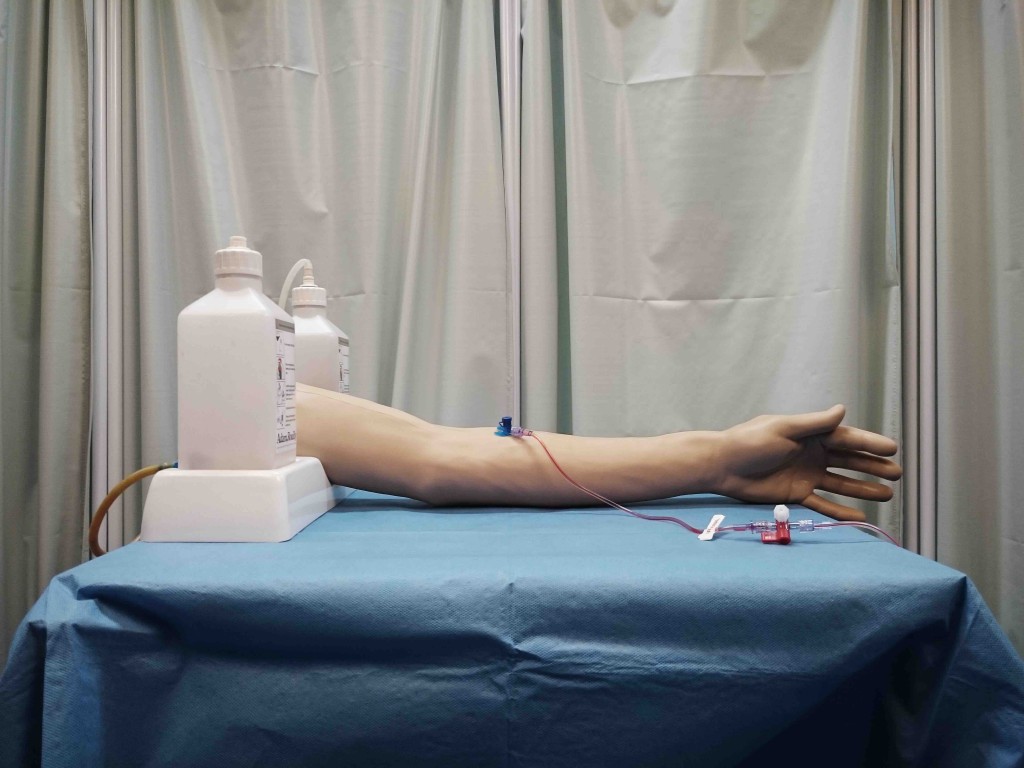A very happy new year to everyone! I hope you all had great Christmas breaks. The wonderful woolly decorations which have been adorning the front of the School of Arts in Gordon Square for the last few weeks are coming down today, marking the end of the festive season, as we all settle into the new term, and our familiar routines.
There’s already lots of news and events circulating, both about staff and students. I’m delighted here to pass on the success of one of our current MA History of Art with Photography students, Steven Kenny. Steven has won a Royal Photographic Society award for his photograph of a medical simulation model for taking blood. I shall post it below, and hope that everyone’s post-Christmas stomach is up to some visceral imagery! Taking Blood was photographed whilst exploring a hospital’s medical simulation centre, and this is what Steven told us about the image: “On confrontation the object is both strange and compelling. Used as an anatomical tool for teaching doctors, the object, alone and detached, stands as a stark reminder of the body’s reliance on clinical intervention.”
Staff have already been busy organising events for this term. The next Murray Seminar on Medieval and Renaissance Art will be taking place on Wednesday 20th January (5pm, Keynes Library), and the speaker is someone who will be familiar to a good number of you – Dr. Zuleika Marat, who co-led our departmental field trip to Florence last Easter, along with Dr. Joanne Anderson! Do re-read the wonderful blog posting which Joanne wrote for us, to refresh your memory of her tales of Florence. Zuleika will be talking to the title: ‘“I have not seen more precious tombs and burials with greater pomp”: Guariento and the Tomb of Doge Giovanni Dolfin in Santi Giovanni e Paolo, Venice’. This splendid tomb once consisted of a hanging canopy and tomb by Andrea da San Felice and decorations by the famous painter Guariento. Dr. Murat will be proposing a new hypothesis and a visual reconstruction of this important monument in one of Venice’s most significant locations.
The following week, on Tuesday 26th January, the History and Theory of Photography Research Centre will be holding its next seminar (6pm, Keynes Library). Dr. Marta Weiss will be talking about the new material she discovered while researching the current exhibition at the Victoria and Albert Museum, marking the bicentenary of the birth of Julia Margaret Cameron, 150 years after she first exhibited her work there. Colin Ford (Founding Head, National Museum of Photography, Film and Television [now National Media Museum] Bradford), who has worked extensively on this important photographer, will be responding.
I’m going to finish with some self-serving publicity! As some of you will know, one of my areas of particular research interest is the eighteenth-century British country house, and I co-organised a conference with Dr. Susanna Avery-Quash from the National Gallery on the subject last March: ‘Animating the Eighteenth-Century Country House’. It was a great success, and a pleasure to see familiar faces from Birkbeck in the audience! While we were putting together the programme for this event, Susanna and I began pondering comparative lack of knowledge about and interest in the counterparts to these country estates: the London town houses of the period. Wilton, for example, is much visited and discussed, but we know so much less about the property which the Pembroke family owned in London: Pembroke House. Chatsworth has officially been recognised as one of the country’s favourite national treasures, but most of those who visit it know little of Devonshire House, which the Devonshires once owned in the capital. This is in part because these town houses were often leased, rather than being passed down through generations, as country estates were. But, most critically, many London town houses, including both Pembroke House and Devonshire House, no longer exist, having been demolished in the early twentieth century.
We have therefore organised a follow-up conference: a collaboration between Birkbeck, the National Gallery, and the Paul Mellon Centre for Studies in British Art: ‘Animating the Georgian London Town House’ (17th March, Sainsbury Wing Lecture Theatre, National Gallery). Speakers will be discussing both famous and little-remembered town houses, exploring how these residences were designed, furnished, and ornamented. We will also be considering the significance and function of these properties for owners and their families, and the varied experiences of guests and visitors. Do follow the link to find out more about the great line-up of speakers we’ve secured for the day. I hope we can tempt some of you to book places, and to come along to hear more about this fascinating topic!



